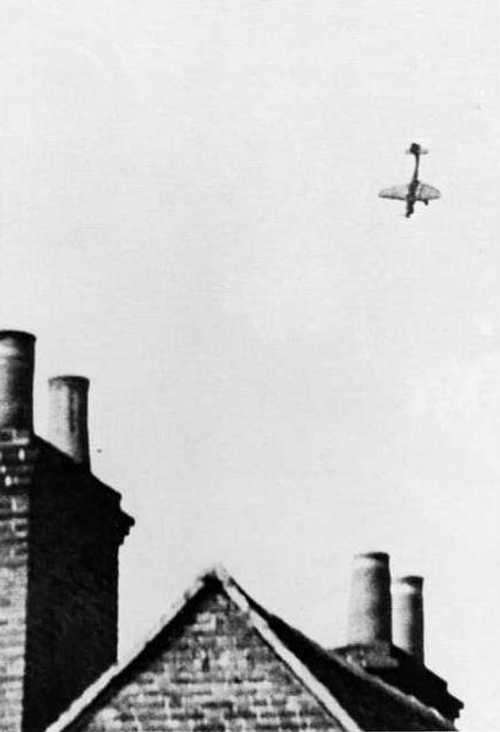
German Air Force
Not a beginning, but an end ...
H.M. Government
May look a bit like a standard Ju-87 attack dive, but it is not. The Stuka in this image has just been shot up by a Hawker Hurricane and, within seconds, the crew - Unteroffiziers August Dann and Erich Kohl, 1 Gruppe, StuKampfGeschwader 77 - would be dead in the flaming wreck, West Boyle, near Chichester, 18 August 1940. The deployment of Stukas over England had presented difficulties from the start of the Battle of Britain. It should not have been a surprise to the Luftwaffe, but was, and an unpleasant one, that operating these slow, rather clumsy dive bombers from, at least initially, bases some way within the French coast was asking for trouble, and could only be done with effective fighter escort. However, the Stukas found it difficult to co-ordinate with the faster "Emils", which found effecting the order to give very close support difficult in practice, even if the fighters were not (and they often were) forced to respond to Spitfire and Hurricane threats so as to avoid being shot down themselves. 18 August, 1940 was selected for a major effort on the part of Luftflotte II against a range of first-priority targets, mainly around London (although, for some reason, II Gruppe, KampfGeschwader 27 was detailed to bomb Liverpool Port). A major commitment of Stukas, in the form of elements of StuG 77, was detailed to attack the RAF stations at Ford and Thorney Island, and the radar mast at Poling. As far as the Stukas were concerned, the attack initially went well; they were all but unopposed, and inflicted serious damage, knocking out the Poling radar station (which, however, was immediately "covered" by adjacent masts in the British radar "shield"). However, potential problems were already emerging, with the MeBf 109E escort adopting the logical but risky tactic of slowing well behind the Stukas in order to save fuel. They never really regained contact - which is more than could be said of Nos. 43 and 601 (Hurricane) squadrons, which attacked the returning Stukas. The escorting "Emils" were too far away to intervene and, in any case, were forced to devote their attentions to attacks from Spitfire and Hurricane squadrons targeted at them. The result was something of a "death ride" for StG 77. By the end of the day, Gruppe I/Stg 77 had lost 11 aircraft (including 1 that proved to have been irreparably damaged). Their colleagues in II and III/Stg 77 were, in a manner of speaking, more fortunate; but they still lost some 8 aircraft, including 3 irreparably damaged. Few Stukas managed to return to France without at least some holes in them. Hauptmann Herbert Meisel, Group Commander of III/SG 77, was among the dead. One result of the operations of 18 August operations was the immediate withdrawal of the Stukas from operations over southern England; in future, their operations in the area were pretty well confined to more suitable anti-shipping duties over the Channel. The Stuka would go on to operate usefully over the Eastern Front (it is worth bearing in mind that the supreme Stuka ace, Rudel, was still at this point a poorly-regarded second-echelon flier who had yet to fly a combat mission). Nonetheless, its propaganda reputation as an unstoppable wonder weapon had taken a very severe beating. Best regards, JR.
2798 Views
1/10/2013
